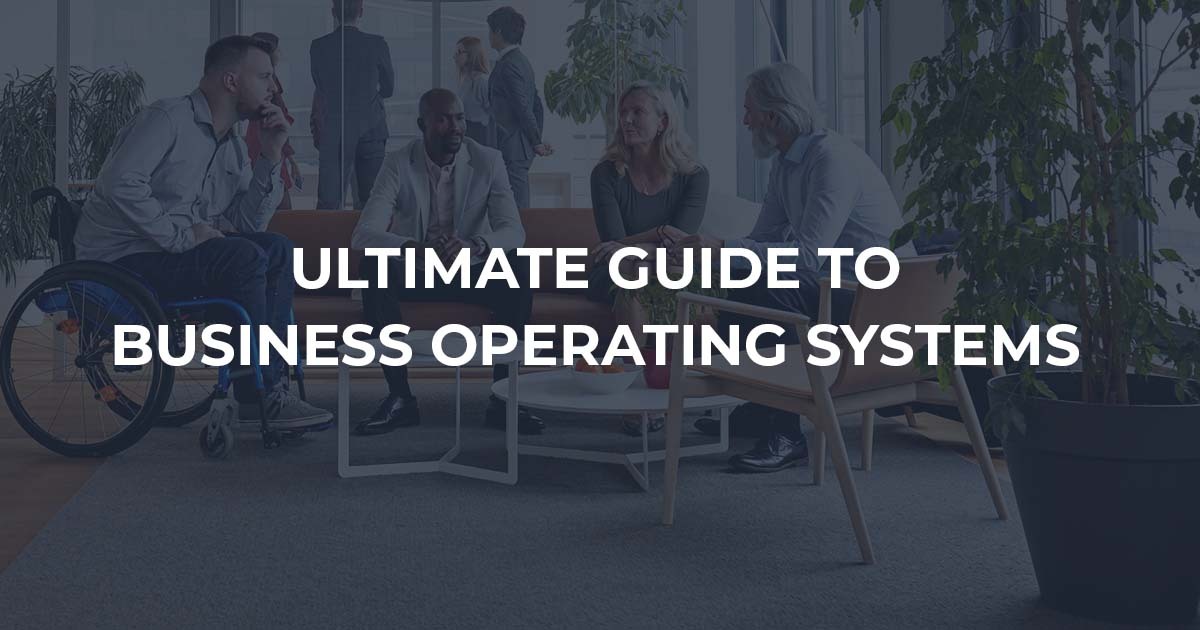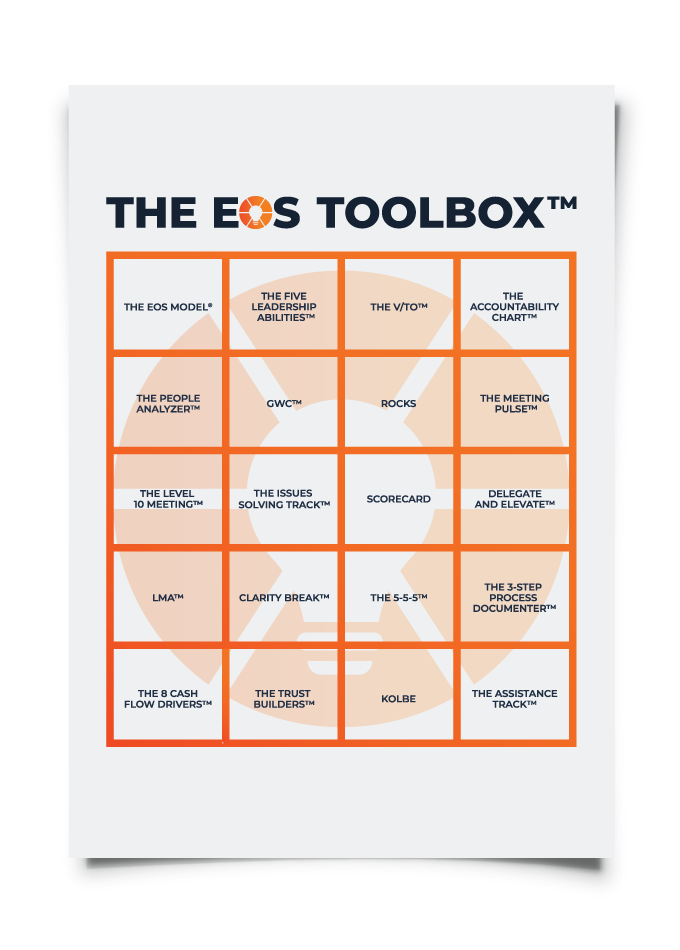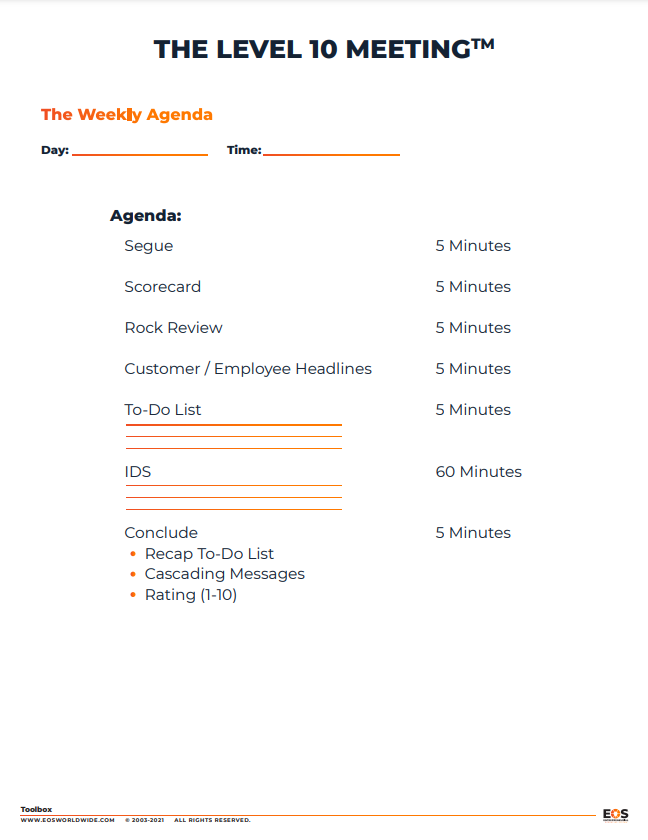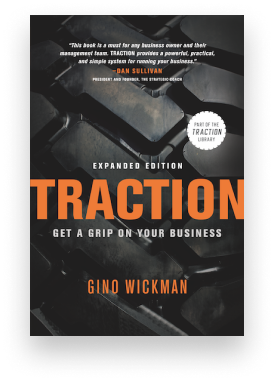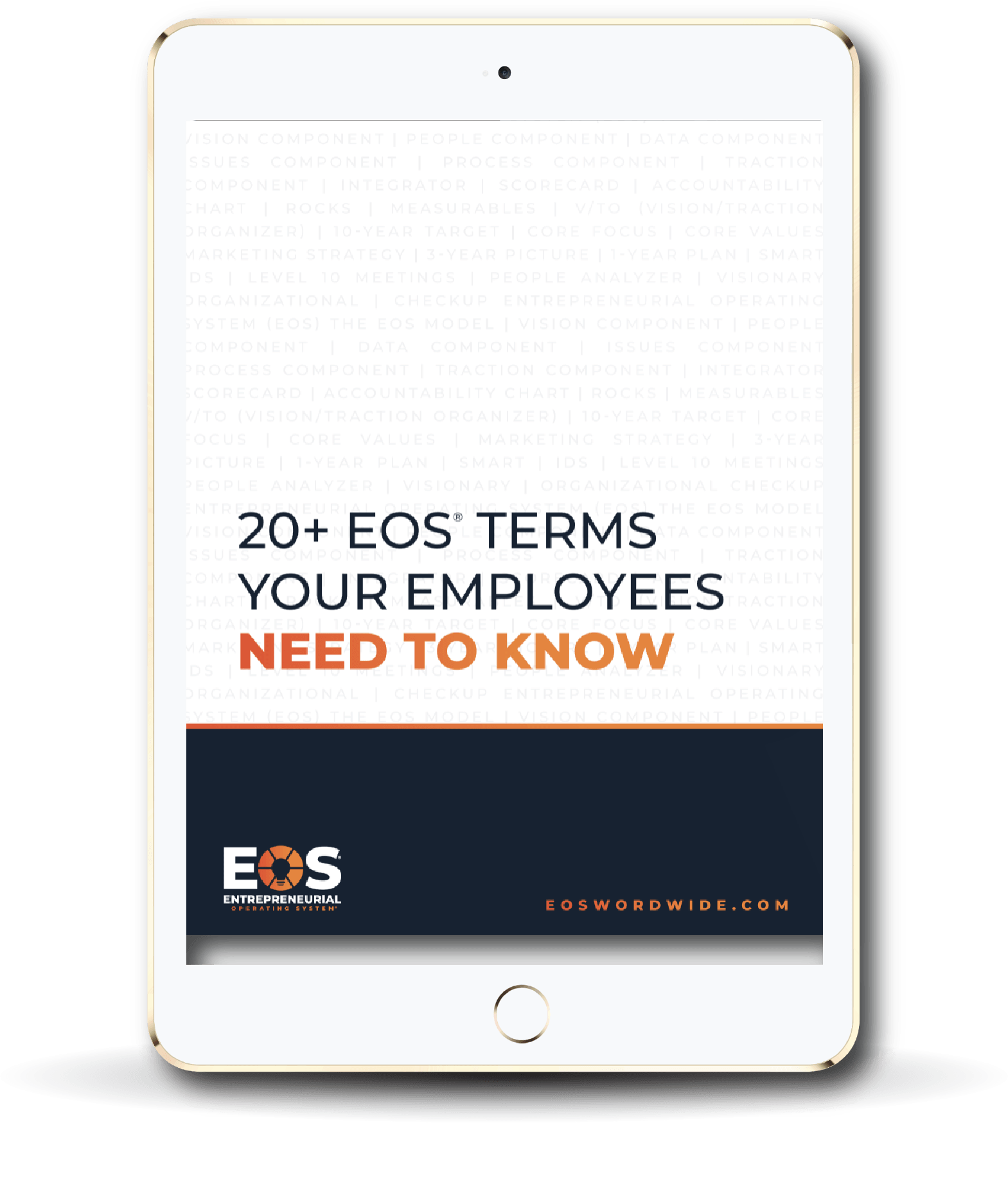Entrepreneur Challenges: Turn Challenges into Business Success
Hitting the Ceiling is Inevitable
If your entrepreneurial business is hitting the ceiling, you’re in good company — some of the most successful entrepreneurs we know have faced peaks, valleys, and plateaus that created doubt and had them questioning their ability to lead. This guide will help you turn your entrepreneurial challenges into success.
Every successful business leader knows that the path to success is not a straight line:
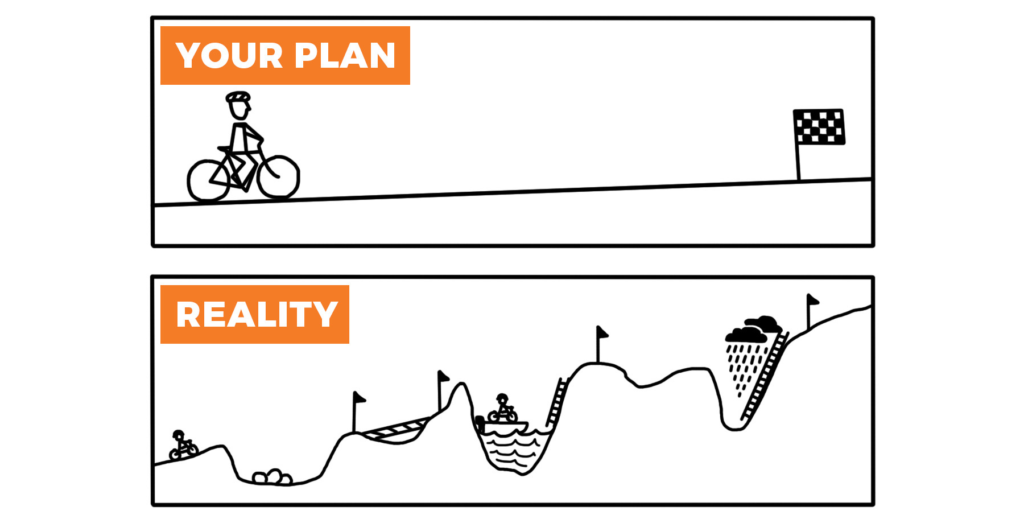
Ever feel like that little guy on the bike? We get it. And do you want to know a secret? The ‘valleys’ are often caused by the same issues over and over again. But don’t worry; you can climb that hill – or as we say at EOS®: we can help you to break through the ceiling.
This guide will provide you with advice from experienced business leaders and access to simple, powerful tools and concepts that you can put into action right now. Let’s get started.
What you'll Learn
- How to recognize and recover from entrepreneurial burnout
- The key challenges that are holding you back and how to move forward
- How one company turned its business challenges into its greatest success
- Tools and resources for getting your business back on track - and staying on track
Who this Guide is For
- Entrepreneurs and leadership teams whose businesses have hit a ceiling
- Business owners troubled by uncertainty
- Leaders who have had success but struggle to maintain it
- Leaders of a business that has hit the ceiling
- Innovators with a thirst for greater challenges and more excitement
Click on any chapter to scroll directly to it
TABLE OF CONTENTS
Chapter 1
Is Your Business Running You?
Countless business owners and visionaries before you stood where you are and faced some of the same business challenges you may be facing today:
- Money issues: Lack of capital or cash flow
- Leadership issues: Having a clear vision and getting everyone aligned around that shared vision
- Operational issues: Knowing how to scale your business up (or down) while keeping productivity and quality high
- People issues: Trouble attracting or retaining top talent and having the right people in the right seats
- Data issues: Not measuring performance and/or holding people accountable with a company Scorecard
- Brand issues: Ineffective marketing and brand awareness (or total lack of)
Unfortunately, these problems can cause you to burn out – right when your business needs you most. Do you recognize yourself in any of these 10 signs of business owner burnout?
You’re exhausted and overwhelmed
You’re frustrated and cynical
You can’t think well
Your performance is dropping
You’re always at work…even when you’re not at work
You treat your people poorly and family relationships are suffering
Nothing seems good enough
You socialize less
You can’t sleep
You have health issues
Bonus burnout moment: You feel like an imposter!

As we said in the beginning, you’re in good company here. At some point you may experience one or all of these feelings, and while it’s normal, that’s hardly any consolation when your team is looking at you to lead.
But you’ve got to keep pedaling that bike.
Read on to find out how to start tackling these obstacles.
And if you’re feeling a little winded, check out Chapter 7 for tips on how to recover.
Chapter 2
Getting the Right People in the Right Seats
One of the biggest challenges to any business, large or small, is getting the right people in the right seats. This includes everyone from the leadership team to the frontline employees. When people are in the wrong seat, they suffer and cause others to suffer. This will negatively impact productivity, both customer and employee relationships, and your business as a whole.
At EOS, we have a tool that enables leaders to solve this issue quickly and objectively. It’s called GWC™ which stands for Gets it, Wants it, and has the Capacity to do It.
It requires you to ask three questions of your people:
Do they Get it?
Do they Want it?
Do they have the Capacity to do it?
The answer to each of these questions is a non-negotiable “yes” or “no”. When you answer these questions openly and honestly, if any one of the three answers is a “no”, then that person is in the wrong seat. It’s a very powerful exercise that can highlight the real issues a company may be facing.

“Do they Get it”
Means this person has a deep, meaningful understanding of the seat they have been hired for. When someone gets it, they have that intuitive feel, the natural aptitude for understanding what is required to deliver. A “no” simply means that this position isn’t suitable for them and the company to get what it wants, and it’s time to find someone else for this seat.
“Do they Want It”
This is about whether the work positively motivates them on a daily basis. Can they bring their whole self to the game every day, over and over again, with enough energy to move them and the company forward at the pace you require? If this work isn’t what they truly want to do, they may find a way to do other things.
“Capacity to do it”
Capacity is fourfold. Do they have the mental, emotional, physical, and time capacity to do the job – and do it well? Mental capacity relates to their abilities and knowledge. Emotional capacity is their understanding of how ‘what they do’ impacts others. Physical capacity relates to the amount of endurance and dexterity that is required for the seat. Time capacity is tied to the number of days, hours, minutes, and seconds the seat will take. Capacity is the only one of the three GWC questions that can be worked on – if the business is prepared to invest the effort in doing so.
The companion exercise to GWC is to create an Accountability Chart™ for your organization.
The Accountability Chart is a tool that will help you build out the right structure for your organization and determine what roles are needed, who will fill them, and how the roles will support one another. As your company grows, so too will your Accountability Chart. You’ll need to revisit it regularly to determine if your team is structured and staffed appropriately to meet the current business objectives.
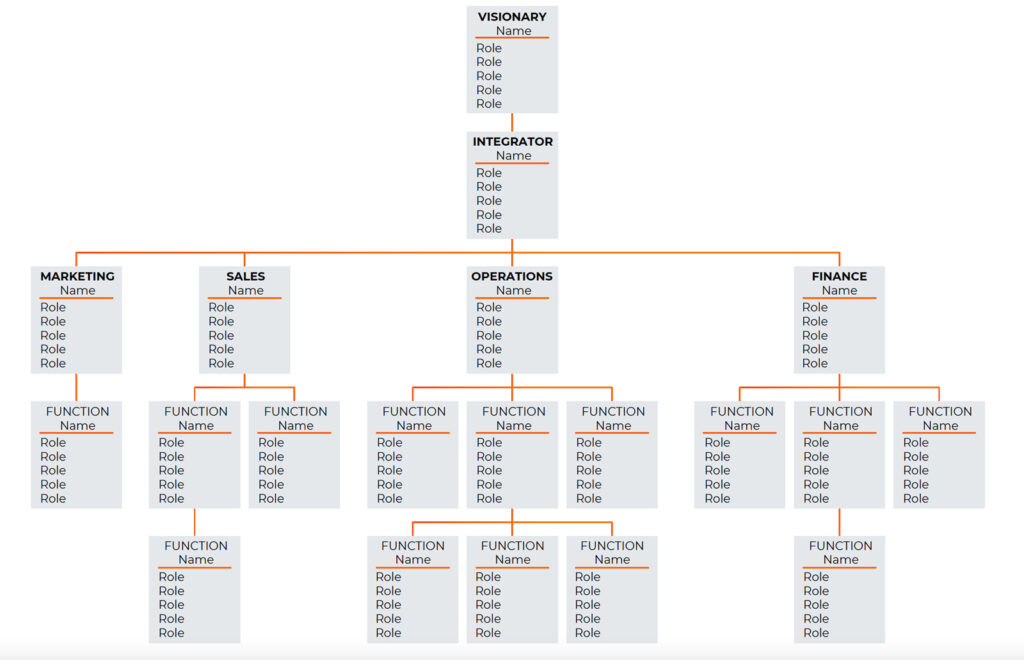
As you can see, the Accountability Chart is like a road map for you to create a complete team with an eye on putting the right people in the right seats.
The Accountability Chart is particularly helpful in times of uncertainty. Many of our clients faced tough decisions in the past year, and we advised them to consider creating a Reverse Accountability Chart. This approach is meant to prepare your business for an economic downturn, such as what we faced during the pandemic.
Under normal circumstances, the Accountability Chart includes identifying empty seats in the business to facilitate growth. The Reverse Accountability Chart is the exact opposite. What would the company look like with 50% less revenue? While it’s certainly not an ideal situation to consider, and you’ll want to keep the concept of the Reverse Accountability Chart to yourself, just knowing that this tool is at your disposal if you need it is part of being a good leader who is ready to face anything.
Your Next Step:
Start organizing your team! Download the Accountability Chart and other free EOS Tools by visiting the EOS Toolbox™.
Get the EOS Business Management Tools
The complete set of Tools used to strengthen and manage any business.
Chapter 3
Sharing Your Vision and Taking Control

At EOS, you’ll often hear us talk about the concept of Vision, Traction, Healthy. Getting your company vision nailed down is a critical step to becoming a healthy organization and getting traction.
So let’s talk about vision
Entrepreneurs are visionaries – they can see into the future five, 10, sometimes 20 years because they are dreamers and idea people. The most successful entrepreneurs can communicate their vision to everyone in their organization. This is what’s known in EOS as a ‘vision shared by all.’ In order to get everyone pedaling in the same direction, you need to get clear on your company vision. It is:
Who you are
Where you are going
How you will get there
You need to document your company vision — get it out of your head and on paper — and then communicate your vision to your leadership team and then out to the entire organization.
When the leadership team isn’t on the same page with the company’s vision, they and the company will end up pedaling in different directions. If you don’t have a written vision that is shared with everyone and owned by everyone in the company, you’ll inevitably have more miscommunication, greater confusion, and wasted effort.
You can use this EOS Tool to help your leadership team define, document, agree on, and share your company’s vision: The Vision/Traction Organizer™ or, V/TO™.
When your team understands your company vision, it can be a huge motivator. The vision gives everyone something to strive for and allows people to reach their full potential because they can ‘see’ your company’s success as well as their own.
Then everyone will be ready to follow your lead and charge up that next hill.
Your Next Step:
Download your copy of the V/TO and document your company vision!
Watch this video to learn how to crystalize your company vision with eight key questions to align your leadership team.
Chapter 4
Laying the Foundation for Organizational Efficiency
If you’re an entrepreneur running a small business, there just aren’t enough hours in the day and many of those hours you do have are filled with unproductive meetings. Unproductive meetings drain resources, zap morale, and can lead to organizational funk including:
- Uncompleted to-dos and stalled projects
- High employee turnover and burnout
- Poor company culture
- Unhappy customers
Level 10 Meetings® are a key piece of keeping your team aligned, being efficient, and learning to put issues on the list during your week instead of interrupting one another when it’s not time-sensitive.

Not Good!
Now imagine if EVERY meeting in your company were to start and end on time. During those meetings, employees identify the most important issues to tackle and participate in decisions and solutions.
They walk out of the meeting with a clear resolution on those issues — solving them once and for all with everyone on the same page. Even better, that one single meeting eliminates all the other meetings for employees that week.

The Level 10 Meeting™ Agenda was developed to take your meetings to a higher level of productivity and satisfaction for everyone in attendance. It will help you:
- Keep your team focused on the most important priorities
- Hold your team accountable for the things they’ve committed to
- Identify, discuss, and truly solve issues — once and for all
So. Much. Accountability. It’s a beautiful thing.
Your Next Step:
Download the Level 10 Meeting™ Agenda
Identify, discuss, and truly solve issues – once and for all.
Chapter 5
Embrace Core Processes for Better Profitability
You can be doing a lot of things right — having a clear vision shared by all, the right people in the right seats, fabulous meetings — and still struggle to be profitable.
Having clearly defined core processes is a key to greater profitability.
Organizations that strengthen their Process Component™ become more consistent, predictable, manageable, and scalable. People become more productive, so the business becomes more profitable.
Your core processes are all about how your company provides its product or service. Every organization has a handful of core processes that make the business run. Usually, these include:
- The HR process: the way your company hires, manages, reviews, promotes, retains, and fires people
- The Marketing process: the way your company gets your message to your target market audience and generates leads for your salespeople
- The Sales process: the way your company converts a prospect into a customer
- The Operations process: the way your company makes the product or provides the service to your customer
- The Accounting process: the way your company manages the flow of money coming in and going out
- The Customer Retention process: the proactive way your company takes care of your customers to keep them happy, coming back, and generating referrals for you

The sweet spot for the number of core processes is somewhere between six and 10. Having too many can be a distraction and paralyze your team. Just like your company vision, your core processes need to be identified, documented, and communicated to the entire organization.
We also recommend that you think about how you deliver services to your clients and define a proven process. A proven process is the three to seven steps that show your customers how you deliver services. It’s a great tool for closing more business and for setting and managing expectations with new customers. You can also use your proven process diagram to onboard new employees.
For example, here is the EOS Process®.
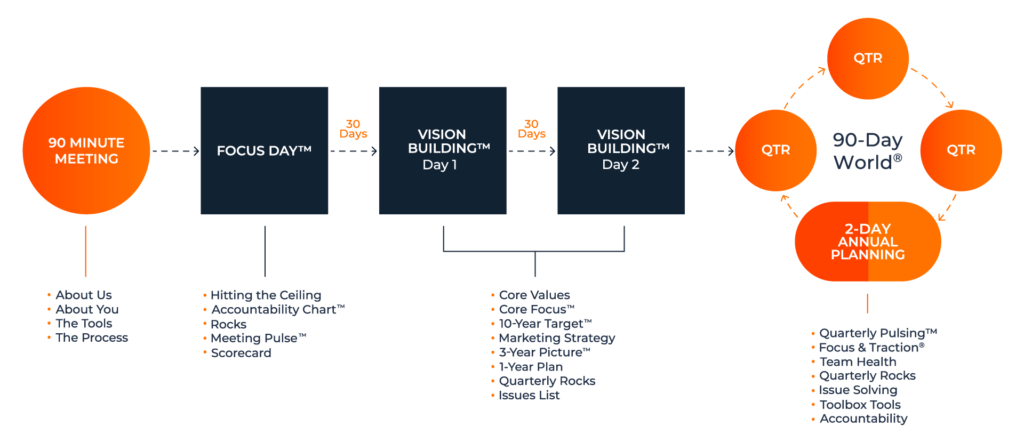
Your Next Step:
Document and share your core processes with your team. Develop a proven process graphic to share with your clients and prospects.
Chapter 6
Creating a Company Culture You Can Be Proud Of
There’s a lot of buzz lately about ‘having a great company culture.’ Why is that so important?
Healthy company culture attracts and retains the top talent needed to reach your company goals and fully realize your company vision. Toxic company culture can destroy your organization from the inside out.
So what is the definition of culture? Culture is defined by the way the people in your company act and how they treat each other. It’s how it feels when anyone interacts with your organization. If anthropologists studied your organization, its people, your leaders, and how they communicate, what would the report say? That’s your culture.

People like to complicate company culture, but it’s actually quite simple. You can build a healthy company culture if you follow these five steps:
Hire
Fire
Review
Reward
Recognize
Creating a culture of gratitude is really very simple: try to make people feel valued and appreciated.

If someone isn’t living your culture, you have to call them out, regardless of how strong that person might be in a job.
If you use your core values to drive your company culture, you won’t go wrong. We’ve proved this thousands of times with our clients and watched them build fantastic companies that had high employee engagement and low turnover rates.
Your Next Step:
Get clear on your core values or refine your existing core values. (You can refer to page 36 in Traction for help.)
Get a grip on your business. Order the book, Traction, by Gino Wickman
Chapter 7
Recovering from entrepreneur Burnout
Recovering from entrepreneur Burnout
Being an entrepreneur is awesome. We know because we spend so much time talking to them about their companies and the legacies they hope to leave, and it always inspires us.
But sometimes it comes at a cost. If you’re not careful, it’s easy to become overworked and lose sight of how to lead. So we ask our clients, “when was the last time you took a Clarity Break™?”
The Clarity Break
A Clarity Break is a set-aside time where you have the intention to just think. During this dedicated thinking time, you get clear on what’s important, what needs to be done, and what’s holding you back. Clarity Breaks are essential for leaders to get refocused.
This may be challenging at first because it requires you to step out of your routine and slow way, way down. But before you know it, Clarity Breaks will become part of your routine – a routine that will save you from burnout.
So what are you supposed to do during these Clarity Breaks and what’s the best way to have them?
By scheduling Clarity Breaks™, you are declaring your time sacred and nothing, short of an act of God, should cause you to cancel that time to think creatively about solving the more significant, thornier issues in your business.

- Beth Fahey,
Certified EOS Implementer®
The characteristics of a good Clarity Break are:
- It is away from your place of business.
- It is at a frequency that you can afford and is helpful to you.
- It is of a duration that allows you to think clearly and achieve some results.
- Generally, they are done without all your electronic devices turned on.
Here are some tips on having a productive Clarity Break:
Put it on your calendar
- Pick a block of time, schedule an appointment with yourself, then keep it. If you wait around for the right time to appear, it won’t.
Work “on” the business
- This is not a time to catch up on email or work on your to-dos. This is time to step back and think, to create clarity, and restore your confidence. Clarity Breaks are thinking time.
Bring a notebook
- We recommend having a notepad or journal handy during your Clarity Breaks to record your thoughts and make lists.
Get away from the office
- A Clarity Break should never be in your office. You have to go to a place where your thoughts are uninterrupted, away from the daily grind.
The other thing you can do is learn how to Delegate and Elevate™.” At EOS we like to say: “Let go of the vine.” Essentially, we’re asking business owners and entrepreneurs to realize that they have to delegate certain tasks, even if it means giving them to someone who is not as efficient as they are (and really, who is? Right?). This will free up your time to get refocused and lead.
Finally, consider connecting with other entrepreneurs — like those in the EOS community. By regularly connecting and learning from the experiences of your fellow entrepreneurs, you will realize that hitting the ceiling or feeling burned out is pretty common and that there is quite a bit you can do about it.
Your Next Step:
Look at your schedule and pencil in a Clarity Break.

Chapter 8
The Colorado Yurt Company: Turning Challenges Into Business Success
The Colorado Yurt Company, like so many businesses, used EOS Tools and concepts to turn their company around during the pandemic to face the future with confidence.

“In my prior business, I took over as president in the fall of 2008,”
begins John Gibson, CEO, and owner of the Colorado Yurt Company.
“In January of 2020, I bought Colorado Yurt.”

But unlike in the prior business, John had decided he was going to implement EOS this time around.
“As a leader and a visionary, you don’t want to feel that a process is going to confine you and keep you from doing what you want to do. With EOS, the process doesn’t confine you; it actually releases you to do the things you should be doing to get things done.”
Timing is Everything
Of course, the fall of 2008 was smack in the middle of the Great Recession and by January 2020, the world was just starting to wake up to the reality of the COVID-19 pandemic.
John laughs at his impeccable sense of timing but quickly adds, “There’s no better time to implement EOS than in the middle of a crisis. From a leadership standpoint, I could see all the challenges the business was facing and the dysfunction of having no structure with meetings or goals.”
By implementing EOS from the get-go, he quickly got the confidence of the existing team in his leadership style. That made it easier to rally everyone around the idea that going forward, the business was going to be run differently.
Opportunity Disguised as Crisis
Even so, when the COVID-19 crisis hit, John knew they could get into deep trouble fast. Fortunately, the opportunity was hiding in plain sight.
“I went to some of our suppliers and found out that the product we used for the windows in our yurts was the same material that was being used for face shields.”

John had already been working with local city managers on getting his company classified as an essential business, and on the very day Colorado shut down the state, the Colorado Yurt Company received its essential business classification.
“We never missed a day,” John says.
Colorado Yurt was able to continue producing its yurts, tipis, and tents while also manufacturing face shields and safety curtains for buses.
And all through the crisis, they continued to work on EOS implementation, which gave them a system to weather the “craziness” of COVID-19 and beyond.
Turning Grapes Into Wine
When John took the reins of the company, there was plenty of work to do on every component of the EOS Model®.
“To get started, I was looking for the low-hanging fruit which the EOS Process could help me with. Little did I know I was standing in a vat of grapes!”
And while John says he knew who they were as a business and as a company, they weren’t clear on the vision or on what their values were. By letting the team at Colorado Yurt help build the vision and values, he has encountered zero resistance because the people had been looking for direction.
“Using EOS, one of the values we identified was ‘being super hungry.’ I wanted to hire people who were hungry for our vision, but through this process, we also discovered that the people here are hungry people, who want to grow and go somewhere new with the business.”
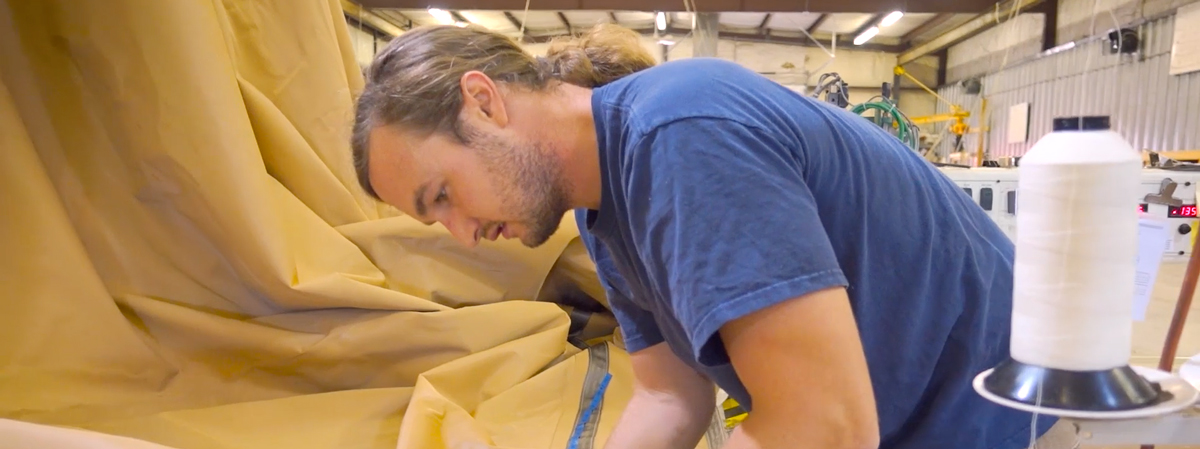
Mastering the Level 10 Meeting™
EOS is a system that identifies not only opportunities but also challenges. When asked what the biggest challenge was in implementing EOS, John says — without missing a beat — “Me.”
“As a classic visionary, the challenge is keeping me focused once we decide on certain Rocks we’re going to run with. I’ll find that one week I’ll say, ‘Ok guys, this week we’re going to do it this way’ and then the next week, ‘we’re not doing it that way, let’s do it this way.’ I keep telling myself that because of the [COVID-19] crisis, I’m not following the rules.”
Of course, identifying the problem is half the solution. For John, a big part of that solution is mastering the Level 10 Meeting.
“I know if I followed the Level 10 Meeting format better, we’d probably be a lot more productive. It’s the most obvious one for keeping us on track. For example, when I came into the company, nobody outside of the two leaders in the business knew what the numbers were or what they were shooting for. Now, by using a Scorecard, we’re getting better at keeping tabs on where we are and where we need to go.”

Gaining Clarity and Making a Difference
For John Gibson, doing the work of implementing EOS has helped bring him clarity. He says going through the process has helped him realize that what’s most important to him is to make a difference in people’s lives — both the people who work for him and the customers he serves.
“I’ve gotten to the point where I’ve gotten really comfortable through this whole process of understanding my personal vision of what I’m going to do with the company and how that’s in alignment with who I am personally.”
After reflecting further on his EOS journey, John sums it up.
“You know, I’m not rich by any means, but in some ways, I’m really wealthy. I’m healthy and I’m happy and this process helped me feel like I’m home. I’m at a point in my life where I get to do exactly what I want to do every day.”
The Colorado Yurt Company is implementing EOS with the help of Certified EOS Implementer® Margaret Dixon
Chapter 9
Tools to Help Small Business Owners Break Through the Ceiling
Companies that run on EOS use a proven set of tools designed to drive their organization toward success. If you’re ready to break through the ceiling and get more from your business, we recommend that you review the tools in our EOS Toolbox™, print them out, and meet with your leadership team.
You can also access, for free on our website, the following resources:
- The Organizational Checkup™ — Use it to assess the strength of your business with this quick questionnaire.
- The EOS Video Library — Explore our YouTube channel to learn more about EOS key concepts and tools.
- The EOS Traction Library — Get a preview of the key EOS books for everyone in your company.
- The EOS Leader™ Podcast — Listen to interviews with entrepreneurs on how they became their best as leaders.
Chapter 10
You Don't Have to Face Entrepreneur Challenges Alone
Even if your business is successful, even if you are running on EOS — you will hit the ceiling again. You may hit the ceiling organizationally, departmentally, and individually. It’s a normal part of the journey of every organization’s growth. Rather than seeing it as a sign of trouble, see it for what it is: growing pains. Your company is ready to enter a new stage of growth, and that’s a good thing.
While the ceiling is inevitable, EOS equips you with the tools, structure, and confidence to break through.
We know we hit you with a lot to think about. But here’s the one thing that we want you to remember: you’re not alone. At EOS, we’ve built a thriving community of business owners and their teams who are all striving to become their best as leaders. By joining the EOS community you’ll be able to connect with and learn from fellow entrepreneurs — and solve your issues for good.
But first, you need to implement EOS in your organization.
You can start by using the free tools and working side-by-side with a Professional EOS Implementer® to help expedite and strengthen your journey to EOS mastery.
There are Professional EOS Implementers all over the world — including in your own backyard. Get connected with one today so you can break through the ceiling.
Let’s do it together!

Request a 90 Minute Meeting
Schedule a meeting to learn more about using the Entrepreneurial Operating System® for your business.
EOS Glossary
Terms to Help you Navigate EOS
EOS® is a language onto itself. Here are a few EOS terms from our glossary that will help you navigate the Entrepreneurial Operating System® for the first time – or at least help clarify a term that you’ve heard before but are unclear about:
Entrepreneurial Operating System® (EOS®): A proven set of simple, practical tools that improves how people in an organization meet, solve problems, plan, prioritize, follow processes, communicate, measure, structure, clarify roles, lead, and manage.
The EOS Model®: Every business is comprised of Six Key Components™ as depicted by the EOS Model. Those six components are: Vision, People, Data, Issues, Process, Traction®. These must be managed and strengthened to create a healthy, well-run business.
Vision Component™: Getting everyone in the organization 100% on the same page with where your company is going and how you’re going to get there.
People Component™: Getting the right people in the right seats.
Data Component™: Using a handful of numbers that give everyone an exact pulse on where things are and when they are off track.
Issues Component™: Strengthening your organization’s ability to identify issues, discuss them, solve them, and make them go away forever.
Process Component™: “Systemizing” your business by identifying and documenting the core processes that define the way to run your business.
Traction® Component: Bringing discipline and accountability into the organization.
Integrator: The leader of a company’s leadership team. Integrators beat the drum, break the ties, harmoniously integrate other major functions in the organization, and accept ultimate accountability for achieving results.
Scorecard: An EOS Tool used to track a handful of numbers that give you a pulse on your business.
Accountability Chart™: Different from an organizational chart, an Accountability Chart defines the right structure for your company and clearly identifies who is accountable for what.
Rocks: The three to seven most important things you must get done in the next 90 days. Employees will typically have one to three individual Rocks each quarter while leadership team members will typically have three to seven individual Rocks.
Measurables: When companies use EOS, everyone “has a number” that is considered their measurable – something they do to contribute value to the organization that is measured on a consistent basis.
V/TO™ (Vision/Traction Organizer™): A two-page document that helps your leadership team define, document, agree on, and share the company vision.
10-Year Target™: A long-range, energizing goal for the organization, ranging from five years to 20 years out.
Core Focus™: Your core focus defines what you are as a company to help you avoid “shiny stuff” and keep you focused on the areas where your business excels. It comes from the intersection of knowing “Why” your company exists and “What” you do in the world.
Core Values: A timeless set of guiding principles that define your culture and the behaviors you expect from each other. They help you determine who fits your culture and who doesn’t and they help you attract like-minded people to your team.
Marketing Strategy: The definition of your ideal customer and the most appealing message to attract them to your business. It should provide a laser-like focus for your sales and marketing efforts.
3-Year Picture™: A definition of what your company will look like, feel like, and be like in three years. The 3-Year Picture creates a powerful image of the future and helps everyone work towards the same vision.
1-Year Plan: Defines your objectives for the year by identifying and crystallizing your revenue target, profit target, and measurables, along with your top three to seven goals for the year.
SMART: Stands for Specific, Measurable, Attainable, Realistic, and Timely. Making goals and Rocks SMART is essential for creating crystal clear communication and for setting the right expectations between you and your team so everyone knows what “done” looks like.
IDS™: Also known as the Issues Solving Track™, IDS is the process your team uses to identify, discuss, and solve issues on an ongoing basis.
Level 10 Meetings™: A weekly meeting with a specific agenda designed to help you stay focused on what’s important, solve issues effectively, and keep your team connected.
People Analyzer™: A simple tool that pulls your core values and Accountability Chart together to help your organization identify if they have the right people in the right seats.
Visionary: Often the company founder, a visionary is a strategic thinker who always sees the big picture and is tuned into the future of your industry. Visionaries are usually great with big relationships and the culture of the organization.
Organizational Checkup®: A 20-question survey that helps measure a company’s strength in the Six Key Components.

